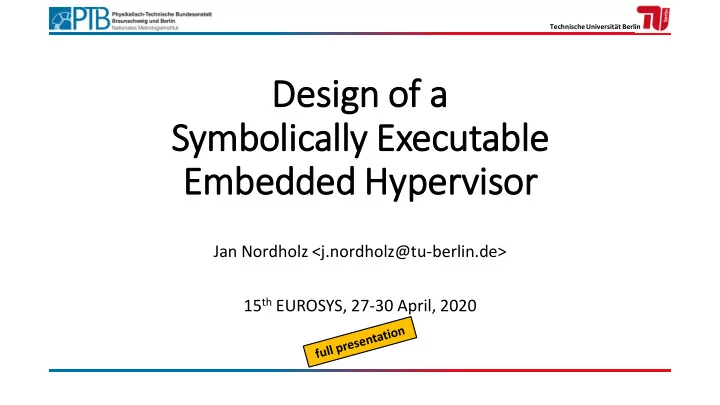

Technische Universität Berlin Desig ign of f a Symboli licall lly Executable le Embedded Hyperv rvis isor Jan Nordholz <j.nordholz@tu-berlin.de> 15 th EUROSYS, 27-30 April, 2020
PHIDIAS – Type PHI ype I I Em Embedded Hype Hyperv rvis isor • Design paradigm: fully embrace static use cases – no compromises • No creation/destruction of VMs • No scheduling • No memory allocation/reclamation • No IRQ registration, rerouting, … • No migration of VCPUs across physical cores → hypervisor executes independently on each core • No dynamic creation of inter-VM communication channels • Use case examples: • Control units in automotive IT • Measuring instruments subject to metrological certification 2
Offli Of line Co Config igurati tion Too oolk lkit • Necessary functionality moved into offline configuration toolkit: • Reads in system configuration (XML) • Target architecture and SoC • Number of VMs, memory requirements, desired IPC channels, IRQ pass- throughs… • Drives compilation of hypervisor • Selects subset of compiled modules • Guesses / probes for cross-compiler • Assigns physical memory resources, allocates virtual address ranges • Generates all page tables (stage-1 per HV instance, stage-2 per VM) • Builds schedule • Emits tree of C structs describing desired system objects • VCPUs, scheduler configuration, IRQ handler table, … → compiled and (loosely) linked to hypervisor image • Wraps final hypervisor image into necessary boot clothing (e.g., uimage) 3
Remainin ing Hype Hyperv rvisor Run Runtim ime Fun Functi tionali lity • What modules are still there at runtime? • Scheduler? No. VM Dispatcher (context switch / state save+restore)? Yes. • MM Subsystem? No, only setting of nested paging controls. • IRQ Handling? Yes, using a fixed dispatch table. • Device Drivers? Yes, bare minimum (IRQ controller, timer, CPU virt. ext.). • Device Emulation? Partially: • Devices tied into HW virtualization: yes (usually IRQ controller and timer). • Other devices? No, but PHIDIAS supports reflection of nested faults into another VM. • Inter-VCPU Communication? Yes: • Among VCPUs of a single VM: through virtual IRQ controller (virtual IPI emulation). • Across VMs: “virtual IRQ” capability allows one VM to trigger another. • Trap / Fault Handler? Yes: • Architectural traps, faults on emulated MMIO ranges: yes. • Hypercalls: only for triggering vIRQs and for reflection management. 5
Sym ymboli lic Ex Executio ion Fr Framework • Implication of our design: all system objects are known a priori • Number (and memory location) of VMs, vIRQ lines etc. fixed at compile time → very limited state space of hypervisor • (Recap) Common OS proof approach: abstraction and refinement • (usually) source code abstract specification • Allows reasoning to capture abstract properties such as “correctness” • Very labor-intensive (e.g. interactive theorem proving) • Result is generic (does not depend on concrete instantiation) 6
Sym ymboli lic Ex Executio ion Fr Framework • Implication of our design: all system objects are known a priori • Number (and memory location) of VMs, vIRQ lines etc. fixed at compile time → very limited state space of hypervisor • Unique proof approach for PHIDIAS: directly analyze machine code → symbolic execution • Machine code intermediate invariants: • No deadlocks • Suspending/resuming VCPUs is performed correctly • Data structures of hypervisor are kept sane • Checking for “correctness” property would require abstract specification • Automated (“push - button”) analysis • Result is bound to a specific instance (i.e. compiled image) 7
Sym ymboli lic Ex Executio ion Fr Framework • Symbolic Execution: commonly used to analyze userspace binaries • ISA support usually only covers unprivileged subset • Adoption of established framework would require adaptation: • Addition of privileged instructions • Addition of privileged resources (e.g., control registers) • Special handling of privileged operations • Many of those would require aborting the current execution trace: • Changing core system controls (paging on/off, cache on/off, access bits on/off, …) • Modification of the current address space • Alternative: custom solution, purpose-built for executing our HV • Drawback: recognizes minimal set of instructions; ARMv8 only 8
Cur Current St State of of De Development • Supported Architectures: ARMv8-A, ARMv7-A, MIPS (VZ), x86_64 • Supported SoCs: RK3399, HiKey 2, RPi 3, RPi 2, Cubieboard, Qemu virt • Proof Engine: ARMv8 only • Push-Button Verification Times: scales with #VCPUs, <8 VCPUs → <2h • Overall Implementation Effort • ≈11 kLOC HV (C + Assembler), ≈4.5 kLOC used per instantiation • ≈6 kLOC configuration toolkit (C) • ≈ 7.5 kLOC proof engine (C), using Z3 as SMT backend 9
Cur Current St State of of De Development • Being worked on: • RISC-V support (HiFive1 rev B) • Transition from self-written to a mature symbolic execution framework • Extension of prover results towards abstract properties • Release as open source project • Aspects worth investigating: • Analyze / optimize cache and TLB footprint of HV code paths • Tune / rewrite bootable HV image to reduce footprint • Measure / improve worst-case latency of hot paths (IRQ delivery, frequent traps) • Try reintroducing dynamic aspects under our umbrella of „pure staticness“ • HV-based big.LITTLE core switching • Pseudo-Ballooning by switching between multiple pregenerated sets of page tables • Shadow paging 10
Thank you for watching! 11
Recommend
More recommend